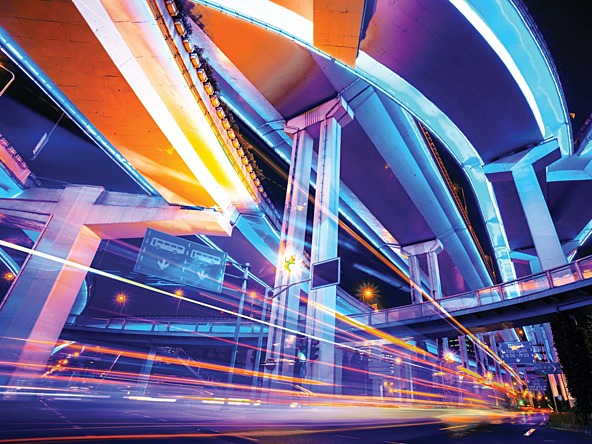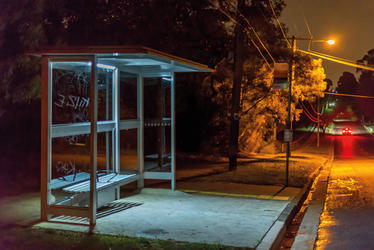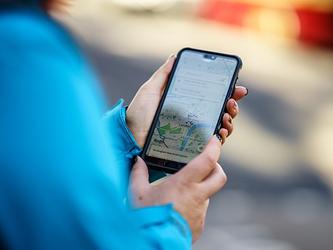Journey through the urban jungle

In 1921, the British census started asking people not just where they lived, but also where they worked and about the journey that they took to get there. At the time, London was a city of six million people, three times the size it had been a century before. It was also a very different city, crisscrossed by a haphazard set of underground railway lines, built independently of each other by speculators and ringed by mainline stations, that the census discovered delivered 370,000 people into the centre of London every day.
The population of the historical City of London – the ‘Square Mile’ at the heart of the capital – had withered from around 130,000 in 1851 to a tenth of that figure by the time of the 1921 census.
If far-sighted Edwardian administrators (the US census didn’t collect detailed commuting data until 1990 ) thought their statistics on how people went to work might be useful, it’s unlikely they imagined the detailed analysis to which their records would one day be subjected.
Professor Steve Redding, an expat Londoner at Princeton University, has used this commuting data to build a sophisticated model of urban growth that predicts: where people will live and work; property values; and commercial sector growth. Using this model, he has concluded that the pattern of London’s spectacular growth in the second half of the 19th century was almost entirely because of the availability of underground and overground railways.
Suburban living
“Our model can explain all of the dramatic separation in the number of people who live and work in the City of London during the course of the late 19th century,” he says. If the model removes the entire railway network in 1921, London’s population would have been just above two million. So urban transport is “essentially explaining nearly all of the growth in greater London over the 19th century”.
This isn’t just academic history; the model created by Redding and his colleagues can explain the growth of most major cities – even today. The invention of suburban living, the dense clusters of industry and other types of specialist jobs, and high-rise buildings that make the most of the limited room in urban areas to expand are – to a large extent – the consequences of transport. But now city planners are grappling with a new set of problems.
As our cities and tastes change, so does our demand for transport – and planning services with different managers and owners (both public and private) using different pricing and ticketing plans, while deciding which infrastructure needs investment and which passengers get priority, is a major headache.
Transport for London (TfL) has a particular problem. “Our drop in trip numbers has been going on since 2015,” says Ian Pring, TfL’s research and insight manager. “It’s consistent with the social and technology factors that we see, such as home shopping and home entertainment. There’s just as much shopping going on, it’s just that people don’t travel so much to do it.”
After decades in which TfL and city planners were exercised by the problem of how to accommodate consistent rises in passenger numbers, tube use was down 2% last year, and bus use has been falling for four years. The London Travel Demand Survey shows that Londoners travelled 2.2 times a day on average in 2016/2017 – 20% less than in 2006-2007. Commuting trips in the period are down 14%.
As a result, TfL faces a funding shortfall. It is also grappling with what Pring understatedly calls a “stretch target”, set by the mayor of London, that 80% of all journeys in the capital be made on foot, by bike or on public transport by 2041. Currently, the indicator hovers around two-thirds and is stable. But the challenge of encouraging behaviour change has led TfL to engage increasingly in qualitative work, cultural analysis and semiotics, to understand why people choose to travel at particular times – in particular ways – and to investigate what a ‘good’ journey would be.

Pain points and irritations
As it seeks to ‘win’ market share, TfL’s customer directorate – which brings together marketing, planning, technology and data – is analysing trip choices using Porter’s five forces model.
The most spectacular growth in travel in London has been in private hire vehicles, up 75% in four years. It’s one thing to know more people are taking an Uber; it’s quite another, however, to work out what would encourage them to take a bike or a bus instead.
TfL has introduced an approach to measure not just the journey time and punctuality for commuters, but how those commuters felt when they were travelling, and whether they would trade a slower journey for a more comfortable one.
This type of analysis has also been at the heart of research being conducted in 10 cities, across eight countries, by Kadence International. Its goal is to find innovative ways to change the way we travel in cities, to remove the pain points, irritations and even dangers that urban dwellers – now more than half of the world’s population – learn to put up with while travelling around a city.
Kadence wants to find new ways for its clients to create products and services to match the aspirations of people who, increasingly, have the choice to work, get their shopping and entertain themselves without leaving the house. The auto sector has noticed. Kadence client Jaguar Land Rover, for example, has created InMotion Ventures, an investment and innovation spin off focusing on non-traditional areas, such as ride-sharing, mobility as a service (MaaS) and autonomous vehicles.
“There’s a lot of research into infrastructure and at the legislative level, but very little that actually asks people about their feelings and what they can tolerate,” says Greg Clayton, managing director at Kadence International. “We have found that this experience is very city-specific because it depends on the infrastructure. Urban mobility solutions depend on the type and size of city, but also on the existing infrastructure.”
The day-to-day reality that Kadence’s research is uncovering suggests that, for most of us, the subjective quality of moving around in a city has not really improved since the census of 1921. “The first thing that struck me about the responses we got was the resignation. This is one of the main impacts on people’s wellbeing,” says Gabi Clark, who has been coordinating the project at Kadence. “There’s always been a perception about mass transport that it’s herding cattle.”

Low expectations
Lack of etiquette and consideration are cited as annoying factors in every city. “From Jakarta, where they’re talking about crazy drivers, to Delhi, where it’s rude people, and Boston, where one person spoke at length about people using their phones and not looking where they’re going,” said Clark.
Even if the problems vary, however, it is still possible to find common trade-offs that can be applied globally, Clark explains. “Would they trade comfort for time? Safety for comfort? A surprising factor is that comfort is actually very important. Expectations of comfort are currently so low that it wouldn’t take a lot to exceed them. A route-planning app such as Citymapper is about getting from A to B in the most efficient way. How about a route that takes you past a Starbucks? It’s the small things, but they make a difference. If you can’t change the infrastructure, this would improve the human dimension.”
For most people, a lack of innovation in the quality of public transport and mass transit is a problem of comfort and convenience. For others, it represents a life-restricting lack of inclusion. Work by Opinium, on behalf of Scope, into the obstacles faced by disabled transport users vividly illustrates the size of the barriers that even basic urban mobility presents.
The research had three phases: it contrasted large samples of disabled people and a nationally representative sample to find out attitudes towards and experiences of using public transport. In the third phase, it examined the disconnects between the two using a diary study of 27 people with visible and invisible conditions or impairments. The quant showed disabled travellers were 10% less likely to take a train and, among them, 18% of 18- to 34-year-olds said travelling less than they would like had prevented them from going to work or finding a job.

Alienation
The qual work, however, captured the experiences and emotions associated with urban mobility for the disabled. “One woman had almost fallen in the gap between the platform and the train, trying to get on. She talked about being mortified and terrified,” says Wez Eathorne, research director at Opinium. While there were some positive stories of help and assistance, the overall perspective was of alienation and infrastructure-based discrimination.
“We did a case study with someone who is incredibly successful in life, but when she takes public transport, the staff refer to her as ‘a wheelchair’. They say, ‘I’ve got to put a wheelchair on’ – in front of her. This isn’t something for Scope or the government to solve – it’s got to be people working in collaboration.”
Opinium’s research also highlighted that, while ageing transport infrastructure presents many problems – for example, no wheelchair ramps on trains – experiences for disabled travellers could be improved considerably with training, service design and creative thinking. “It would not be expensive to create an app, that everyone could access, to let transport companies know you’ll need support to get on the train in an hour’s time,” says Eathorne. “The fact that it doesn’t exist is quite baffling – it seems like a really easy win.”
The joined-up thinking that these changes imply may not be instinctive in the management culture of transport companies, which have traditionally competed with each other and prioritised service-quality metrics about engineering over passengers.
Southeastern, which funnels commuters back and forth to London from 173 stations every day, is attempting to rethink the way it provides its service. In a 2014 Which? survey, it was the lowest-ranked rail company in the UK for customer satisfaction, with only 40% of commuters saying it ran a good service. The company made headlines with its response after claiming that the poor result was because it “takes people somewhere they don’t want to be with money they don’t want to pay”, and that it would be different if the survey had been done on a sunny day.
Instead of focusing only on the indicators that managers look at – such as punctuality, reliability or numbers of people using the service – Howard Barr, head of insights at Southeastern, created focus groups in the summer of 2018 so passengers could talk about their commuting experiences. From behind one-way glass, company managers got to hear the good and bad experiences. “It was eye-opening for them; it seems the best we can hope for is that the train arrives on time, we get a seat, and no children are crying.”
Passengers spoke about the entire journey – planning, parking at a station, finding a toilet, and managing stress by being able to find out if their train had left the previous station. Barr argues that transport companies could consider each journey in its entirety, as a service to the customer, not as a set of discrete hops using different modes of travel.

Digital transaction
In exploring the “pain points and moments of truth”, one aspect of UK train travel was highlighted that shows transport is still seen by rail companies as a set of processes handled by different departments or companies, rather than as a service. “Why does buying a train ticket online give you a 12-digit code, which you then have to put into a machine at the station, which spits out a tangerine paper ticket?” Barr laughs. “This is not what our passengers would think of as a digital transaction.”
Similar questions mystify Sian Gannon, chief operating officer of Tomorrow’s Journey. The B2B start-up was established to create incentives and ways for urban transport companies to cooperate, improving efficiency, but also allowing them to move away from this tangerine-ticket, siloed thinking. One of its first projects has been working with a rail operator to think about how the entire journey could be made better for customers.
“How does a traditionally competitive industry learn to collaborate? How do we get people to feel comfortable with sharing,” asks Gannon, who cites the example of “a leasing company with 100,000 vehicles, and a vehicle service provider that can’t get into a market because of the high cost of entry.” All the better if those vehicles are offered at a train station and the lease is included in the price of a rail ticket.
However, some sharing-economy solutions to transport problems are inefficient, Gannon points out. An extreme example would be the ‘bike graveyards’ that have appeared in Chinese cities as a result of thousands of unwanted rental bikes piling up by the road.
Another example is a service that rents cars by the hour. “When a new mobility service comes to a city, it parks 10 new cars next to 10 vehicles owned by an existing mobility service provider,” says Gannon, who believes it would be better if there was an incentive for the providers to share a common pool of cars.

Crowdsourced data
One way in which joined-up thinking can evolve is by crowdsourcing. Transport app Waze began in Israel 10 years ago, was acquired by Google, and now has 110m users around the world, 2.5m of whom are in the UK. It aggregates crowdsourced road data, submitted by drivers to help optimise journeys. “The more people who use it, the better it is,” says Finlay Clark, UK country manager for Waze.
The firm has partnerships with 700 transport authorities around the world. “We don’t charge them; we just ask them to tell us about roadworks and major traffic events,” says Clark. “Crowdsourced data is now the number one way that TfL gets information about the state of its road network.”
Waze maximises the benefit to drivers so as many as possible continue to contribute data. It could ask motorists to create a complete and accurate picture of potholes in the cities it covers – but it doesn’t because there’s no indication that authorities would act on the data, so the insight wouldn’t help users.
Waze has been controversial; in some places, residents have been surprised by sudden increases in traffic as the local Waze community simultaneously discovers that their street is a time-saving ‘rat run’. But it is also a continuous driver survey that can help improve the decision-making of planners in non-obvious ways. “Some authorities use the data to decide on signalling, others to decide which highways should be built – some even use it to decide on pedestrianisation,” says Clark.
In October 1937, The New York Times reported on a novel experiment in Chicago, in which a cyclist beat a taxi, a train, a car, a bus, a pedestrian and a streetcar through heavy traffic. The digitisation of transport data means this experiment is replicated in every city, millions of times a day, captured by smartphones and driver apps.
Taxify, a competitor for Uber and Lyft, has concentrated on harder-to-reach markets, with an emphasis on data science to optimise its on-demand taxi service. Today, on-demand rides make up 2% of all rides in a city, but Taxify estimates that this proportion will increase to one-third by 2025, because efficient routing will encourage travellers to share rides – a sort of on-demand bussing, especially in places where public transport is limited or unreliable.
The Taxify team uses machine learning, mathematical modelling, operations research and game theory to optimise what it provides. This isn’t just about pushing more people to use cars, however; it also means learning to respond to different needs, and offering services to match.
“Taxify has been successful with motorbikes in Africa; we were also the first ride-hailing platform to launch scooters,” says Taxify data science team lead Andre Karpištšenko.
“In the future, every ride could begin from one platform. Some rides make more sense on a bike or scooter, some in a car. It would be perfect to have one app that combined them all.”
Does dockless bike-sharing need a plan?
In early 2018, spectacular aerial pictures started appearing on the internet of bicycle ‘graveyards’ in some of China’s cities, made up of thousands of abandoned, brightly coloured bikes. The over-expansion of the dockless cycle-sharing market seemed to perfectly demonstrate what happens if you let the market decide how to improve urban mobility without a central plan.
Those bicycle graveyards still exist, but recent research by Ginger Zhe Jin, a professor of economics at the University of Maryland, suggests competition is a good thing if we want more people to cycle. The key is to let the ‘network effect’ work: the more that people use a service, the more useful a service is (think: Airbnb). But how can this apply to bikes?
Jin and her co-authors studied what happened in 59 cities in China when Mobike and ofo, the two largest dockless bike suppliers, competed. Conventional wisdom runs like this: the companies oversupply the market and drive prices down; one firm is driven out of the market and abandoned bikes pile up; the remaining provider raises prices; and fewer people end up cycling. Instead, “we observed not only higher prices and higher sales, but also higher investment and higher bike utilisation,” says Jin.
The network effect of two competing providers means it’s more likely that people who need bikes will find one in the place they need it. More availability means that bikes become more useful, so the hire price stays the same or creeps up a little. And because it’s easier to find a bike, more people cycle.
“Our findings suggest that the reality is much more complicated than winner takes all,” says Jin.
Cao, G, G Zhe Jin, and L-A Zhou ( 2018 ), “Market Expanding or Market Stealing? Platform Competition in Bike-Sharing”, NBER working paper 24938.
Bigger than the internet
While the original electric scooter – the Segway – was deemed clever, but uncool, the opposite is true of e-scooters. These are currently very cool indeed. Around the world, e-scooter hire services are growing at rates that make other mobility services seem sedate: both market leaders have reached 10m rides much faster than Uber or Lyft.
Market leader Lime did not release a scooter until the beginning of 2018, but has investment from Google’s venture capital arm. Its competitor, Bird, launched in late 2017 and has scooters in Paris, Vienna, Tel Aviv, Brussels and many US cities. Both companies are valued at more than $1bn.
One reason for their success has been joined-up thinking. For example, you can use an Uber app to locate Lime scooters in more than 100 cities in the US and Europe, thanks to a partnership.
Bird is trialling a concierge service to deliver e-scooters to customers’ houses by 8am so they can travel to work, while Taxify has already become the first taxi app to include scooter hire as a service in Paris.
Urban Mobility 2020 – letting the citizen speak: By Greg Clayton, managing director, Kadence International
More than half ( 55%) of the world’s population lives in cities – a figure that’s widely expected to rise to 68% by 2050. Getting around increasingly busy and crowded conurbations is a challenge that unites citizens everywhere, as difficult journeys can have a significant impact on economic productivity and individual wellbeing.
Equally, the sector represents tremendous commercial opportunities for many of Kadence’s clients – from established automotive manufacturers to disruptive new mobility service providers; from financial service firms to energy companies; and from fashion brands to telecommunications platforms.
Urban mobility, however, means something completely different depending on where you are in the world. Solutions are heavily contingent on historical infrastructure and regulation, so each city represents a unique identity – and that’s before we talk about climate, market maturity and cultural nuances.
Data in this area is not lacking; valuable and comprehensive studies have been conducted on urban ‘readiness’ for future-proofed mobility solutions, while there is an abundance of transactional and geospatial data detailing people’s movements.
But what about the citizen perspective? When is this voice heard? How do these people feel about their travel experiences, and do their views align globally?
To address this surprisingly overlooked audience, Kadence has undertaken a study exploring urban mobility from the citizen perspective in 10 contrasting cities. These map largely to our company footprint – Los Angeles, New York, London, Berlin, Mumbai, Shanghai, Hong Kong, Tokyo, Singapore and Jakarta. With more than 5,000 interviews, and a wealth of visual stimulus gathered from our local teams, we will gain hitherto unrivalled insight into the urban citizen’s travel experiences.
We will provide detailed commuter journey profiles and assess commuting pain points, as well as showcase reactions to groundbreaking urban mobility concepts. We will also develop and deliver a global segmentation, based on people’s urban travel preferences and life values. These will be used to understand if – despite the cities’ many differences – there are universal needs among urban travellers around the world.
Kadence will hold its global launch of Urban Mobility 2020 on 7 February 2019, in partnership with the London Transport Museum in Covent Garden.
This article was first published in the January 2019 issue of Impact.

We hope you enjoyed this article.
Research Live is published by MRS.
The Market Research Society (MRS) exists to promote and protect the research sector, showcasing how research delivers impact for businesses and government.
Members of MRS enjoy many benefits including tailoured policy guidance, discounts on training and conferences, and access to member-only content.
For example, there's an archive of winning case studies from over a decade of MRS Awards.
Find out more about the benefits of joining MRS here.














0 Comments